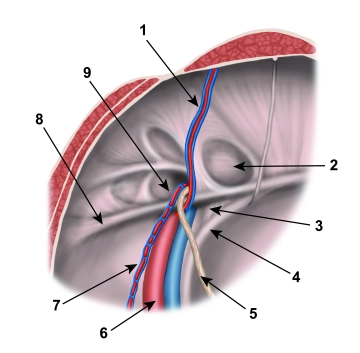Inguinal region from the inside: (1) A. and V. epigastrica inferior, (2) medial = direct inguinal hernia portal, (3) femoral hernia portal, (4) Lig. pectineale (Cooper), (5) Ductus deferens, (6) A. and V. iliaca externa, (7) A. and V. testicularis, (8) Tractus iliopubicus, (9) lateral = indirect inguinal hernia portal
The inguinal region (transition between the anterior abdominal wall and lower extremity) has several weak points through which a hernia sac with or without contents can protrude through the abdominal wall (women are more prone to femoral hernias, men to inguinal hernias). Below the inguinal ligament, the inguinal canal is divided into two compartments by a separation of the inguinal ligament (Arcus iliopectineus): the Lacuna vasorum and the Lacuna musculorum.
Lacuna vasorum
- Located next to the pubic bone, it serves as the passageway for the A. and V. iliaca externa (→ A. and V. femoralis, arrangement: artery lateral to the vein). Additionally, the R. femoralis of the N. genitofemoralis passes through it laterally, and the deep inguinal lymph nodes (Rosenmüller) are found caudally medial within it. The Lacuna vasorum represents the internal hernia gap for femoral hernias (through the femoral septum next to the V. femoralis).
Lacuna musculorum
- Located lateral to the Lacuna vasorum, it serves as the passageway for the M. psoas major and M. iliacus (together = M. iliopsoas) as well as the N. femoralis and N. cutaneus femoralis lateralis (cranially).

